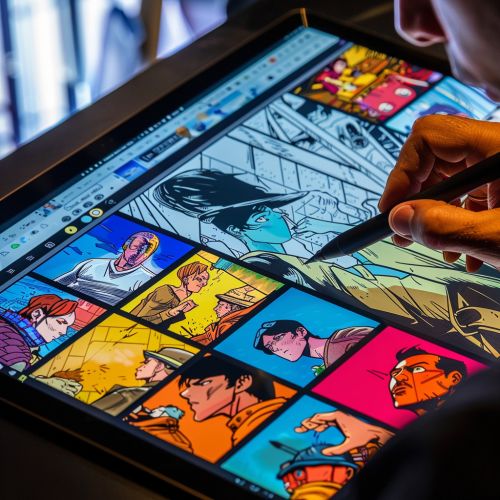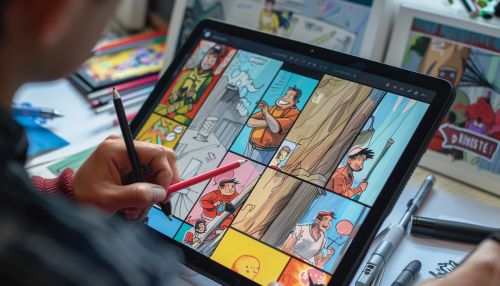Digital Comics
Introduction
Digital comics, also known as webcomics or online comics, represent a modern evolution of the traditional comic book format. These comics are created, distributed, and often read on digital platforms such as computers, tablets, and smartphones. The digital medium has allowed for innovative storytelling techniques, interactive elements, and a broader reach to global audiences. This article delves into the intricacies of digital comics, exploring their history, creation processes, distribution methods, and impact on the comic industry.
History of Digital Comics
The history of digital comics can be traced back to the early days of the internet. In the mid-1990s, as the World Wide Web began to gain popularity, artists started to experiment with publishing their work online. One of the earliest examples is the webcomic "Doctor Fun," created by David Farley in 1993. This pioneering effort paved the way for other creators to explore the potential of the digital medium.
The late 1990s and early 2000s saw a significant increase in the number of webcomics, with platforms like Keenspot and Modern Tales providing a space for artists to showcase their work. The rise of social media and crowdfunding platforms in the 2010s further revolutionized the industry, allowing creators to reach wider audiences and secure funding directly from fans.
Creation of Digital Comics
Creating digital comics involves several steps, from conceptualization to final publication. The process typically includes:
Scriptwriting
The first step in creating a digital comic is scriptwriting. This involves developing the story, characters, and dialogue. Writers often use software like Final Draft or Celtx to format their scripts.
Storyboarding
Storyboarding is the process of planning the visual layout of the comic. Artists create rough sketches of each panel to determine the flow of the story and the placement of characters and dialogue. Tools like Adobe Photoshop and Clip Studio Paint are commonly used for this purpose.
Artwork
The artwork phase involves creating the final illustrations for the comic. Artists use digital drawing tablets and software to produce high-quality images. Programs like Adobe Illustrator and Procreate are popular choices among digital comic artists.
Lettering
Lettering is the process of adding text to the comic. This includes dialogue, sound effects, and narration. Letterers use software like Adobe Illustrator or specialized tools like Comic Life to ensure the text is clear and visually appealing.
Coloring
Coloring adds depth and emotion to the comic. Artists use digital tools to apply colors, shading, and highlights to the illustrations. Software like Adobe Photoshop and Corel Painter are commonly used for coloring.
Publishing
Once the comic is complete, it is ready for publication. Digital comics can be published on personal websites, webcomic platforms, or through digital comic stores like ComiXology and Webtoon.
Distribution Methods
Digital comics can be distributed through various channels, each with its own advantages and challenges.
Webcomic Platforms
Webcomic platforms like Webtoon and Tapas provide a space for creators to publish their work and reach a large audience. These platforms often offer monetization options, such as ad revenue sharing and premium content subscriptions.
Digital Comic Stores
Digital comic stores like ComiXology and Amazon Kindle offer a marketplace for creators to sell their comics. These platforms provide a convenient way for readers to purchase and read digital comics on their devices.
Social Media
Social media platforms like Instagram, Twitter, and Facebook allow creators to share their work with a broad audience. Many artists use these platforms to build a following and drive traffic to their primary distribution channels.
Crowdfunding
Crowdfunding platforms like Kickstarter and Patreon enable creators to secure funding directly from their fans. This model allows artists to maintain creative control and produce high-quality work without relying on traditional publishers.
Impact on the Comic Industry
Digital comics have had a profound impact on the comic industry, influencing both creators and consumers.
Accessibility
Digital comics have made it easier for readers to access a wide variety of content. With a few clicks, readers can explore comics from around the world, often for free or at a low cost. This accessibility has democratized the medium, allowing independent creators to reach a global audience.
Innovation
The digital medium has enabled innovative storytelling techniques that are not possible in traditional print comics. For example, some digital comics incorporate animation, sound effects, and interactive elements to enhance the reading experience.
Monetization
Digital comics have opened up new monetization opportunities for creators. Through platforms like Patreon and Kickstarter, artists can secure funding directly from their fans, allowing them to produce high-quality work without relying on traditional publishers.
Challenges
Despite the many advantages, digital comics also face challenges. Piracy is a significant issue, as digital content can be easily copied and distributed without permission. Additionally, the sheer volume of content available online can make it difficult for creators to stand out and attract an audience.
Future of Digital Comics
The future of digital comics looks promising, with advancements in technology and changing consumer habits driving growth in the industry.
Virtual Reality and Augmented Reality
Virtual reality (VR) and augmented reality (AR) technologies have the potential to revolutionize digital comics. These technologies can create immersive reading experiences, allowing readers to interact with the story in new and exciting ways.
Artificial Intelligence
Artificial intelligence (AI) is also poised to impact the creation and distribution of digital comics. AI tools can assist with tasks like scriptwriting, artwork, and marketing, making it easier for creators to produce high-quality content.
Blockchain Technology
Blockchain technology offers a potential solution to the issue of piracy. By using blockchain to create secure, verifiable digital ownership records, creators can protect their work and ensure they receive fair compensation.
Conclusion
Digital comics represent a dynamic and evolving medium that continues to push the boundaries of traditional storytelling. With advancements in technology and new distribution methods, the future of digital comics looks bright. As more creators and readers embrace the digital format, the industry will continue to grow and innovate, offering exciting new possibilities for the world of comics.


